英语语言学讲义Chapter4 Syntax
- 格式:pdf
- 大小:332.78 KB
- 文档页数:12
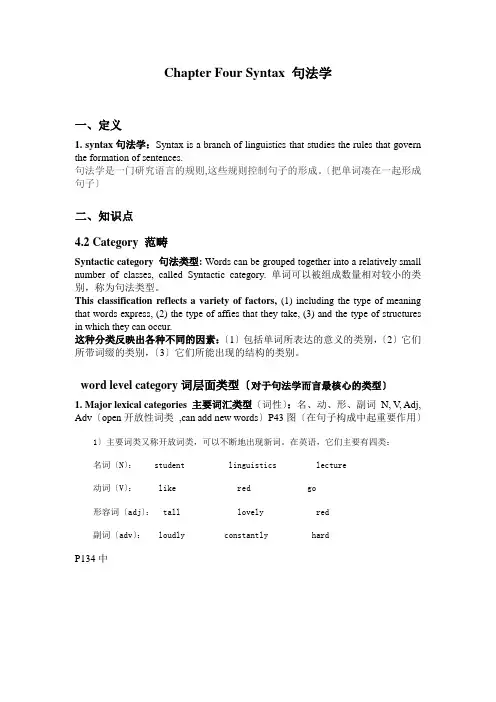
Chapter Four Syntax 句法学一、定义1. syntax句法学:Syntax is a branch of linguistics that studies the rules that govern the formation of sentences.句法学是一门研究语言的规则,这些规则控制句子的形成。
〔把单词凑在一起形成句子〕二、知识点4.2 Category 范畴Syntactic category 句法类型: Words can be grouped together into a relatively small number of classes, called Syntactic category. 单词可以被组成数量相对较小的类别,称为句法类型。
This classification reflects a variety of factors, (1) including the type of meaning that words express, (2) the type of affies that they take, (3) and the type of structures in which they can occur.这种分类反映出各种不同的因素:〔1〕包括单词所表达的意义的类别,〔2〕它们所带词缀的类别,〔3〕它们所能出现的结构的类别。
word level category词层面类型〔对于句法学而言最核心的类型〕1. Major lexical categories 主要词汇类型〔词性〕:名、动、形、副词N, V, Adj, Adv〔open开放性词类,can add new words〕P43图〔在句子构成中起重要作用〕1〕主要词类又称开放词类,可以不断地出现新词。
在英语,它们主要有四类:名词〔N〕: student linguistics lecture动词〔V〕: like red go形容词〔adj〕: tall lovely red副词〔adv〕: loudly constantly hardP134中2. Minor lexical categories 次要词汇类型〔词性〕:限定、程度、量词、助动、介、代、连、叹Det, Deg, Qual, Aux, Prep, Pron, Conj, Int 〔close封闭性词类, words are fixed不添加新词〕P43图2〕次要词类又称闭合词类。
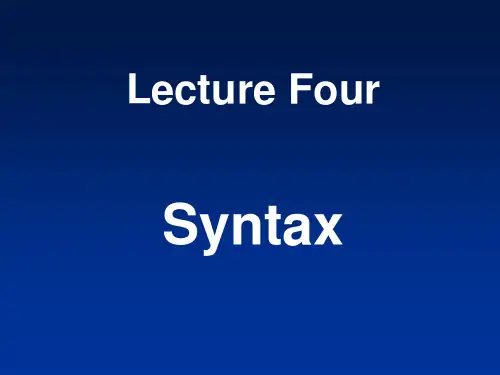
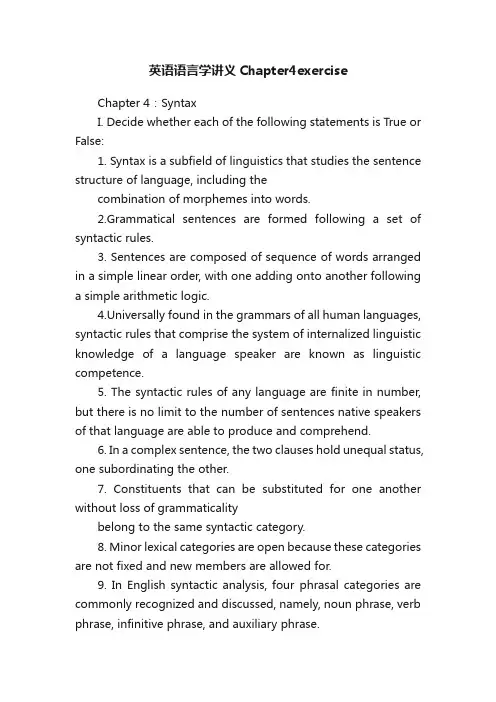
英语语言学讲义Chapter4exerciseChapter 4:SyntaxI. Decide whether each of the following statements is True or False:1. Syntax is a subfield of linguistics that studies the sentence structure of language, including thecombination of morphemes into words.2.Grammatical sentences are formed following a set of syntactic rules.3. Sentences are composed of sequence of words arranged in a simple linear order, with one adding onto another followinga simple arithmetic logic.4.Universally found in the grammars of all human languages, syntactic rules that comprise the system of internalized linguistic knowledge of a language speaker are known as linguistic competence.5. The syntactic rules of any language are finite in number, but there is no limit to the number of sentences native speakers of that language are able to produce and comprehend.6. In a complex sentence, the two clauses hold unequal status, one subordinating the other.7. Constituents that can be substituted for one another without loss of grammaticalitybelong to the same syntactic category.8. Minor lexical categories are open because these categories are not fixed and new members are allowed for.9. In English syntactic analysis, four phrasal categories are commonly recognized and discussed, namely, noun phrase, verb phrase, infinitive phrase, and auxiliary phrase.10. In English the subject usually precedes the verb and the direct object usually follows the verb.11. What is actually internalized in the mind of a native speaker is a complete list of words and phrases rather than grammatical knowledge.12. A noun phrase must contain a noun, but other elements are optional.13. It is believed that phrase structure rules, with the insertion of the lexicon, generate sentences at the level of D-structure.14. WH-movement is obligatory in English which changes a sentence from affirmative to interrogative.II. Fill in each of the following blanks with one word which begins with the letter given:15. A s________ sentence consists of a single clause which contains a subject and a predicate andstands alone as its own sentence.16. A s______ is a structurally independent unit that usually comprises a number of words to forma complete statement, question or command.17. A s______ may be a noun or a noun phrase in a sentence that usually precedes the predicate.18. The part of a sentence which comprises a finite verb or a verb phrase and which says something about the subject is grammatically called p_________.19. A c_________ sentence contains two, or more, clauses, one of which is incorporatedinto the other.20. In the complex sentence, the incorporated or subordinate clause is normally calledan e_______ clause.21. Major lexical categories are o___ categories in the sense that new words areconstantly added.22. A _____ Condition on case assignment states that a case assignor and a caserecipient should stay adjacent to each other.23. P_______ are syntactic options of UG that allow general principles to operate in one way or another and contribute to significant linguistic variations between and among natural languages.24. The theory of C_____condition explains the fact that noun phrases appear onlyin subject and object positions.III. There are four given choices for each statement below. Mark the choice that can best complete the statement:25. A sentence is considered ____ when it does not conform to the grammatical knowledge in themind of native speakers.A. rightB. wrongC. grammaticalD. ungrammatical26. A __________ in the embedded clause refers to the introductory word that introduces theembedded clause.A. coordinatorB. particleC. prepositionD. subordinator27. Phrase structure rules have ____ properties.A. recursiveB. grammaticalC. socialD. functional28. Phrase structure rules allow us to better understand _____________.A. how words and phrases form sentences.B. what constitutes the grammaticality of strings of wordsC. how people produce and recognize possible sentencesD. All of the above.29. Syntactic movement is dictated by rules traditionally called ________.A. transformational rulesB. generative rulesC. phrase structure rulesD. x-bar theory30. The theory of case condition accounts for the fact that __________.A. noun phrases appear only in subject and object positions.B. noun phrases can be used to modify another noun phraseC. noun phrase can be used in adverbial positionsD. noun phrase can be moved to any place if necessary.31. The sentence structure is ________.A. only linearB. Only hierarchicalC. complexD. both linear and hierarchical32. The syntactic rules of any language are ____ in number.A. largeB. smallC. finiteD. infinite33. The ________ rules are the rules that group words and phrases to form grammatical sentences.A. lexicalB. morphologicalC. linguisticD. combinational34._______ rules may change the syntactic representation of a sentence.A. GenerativeB. TransformationalC. X-barD. Phrase structureIV. Define the following terms:35. syntax 36. Sentence 37. coordinate sentence 38. syntactic categories39. grammatical relations 40. linguistic competence 41. transformational rules42. D-structureV. Answer the following questions:43. What are the basic components of a sentence?44. What are the major types of sentences? Illustrate them with examples.45. Are the elements in a sentence linearly structured? Why?46. What are the advantages of using tree diagrams in the analysis of sentence structures?47. What is NP movement. Illustrate it with examples.。
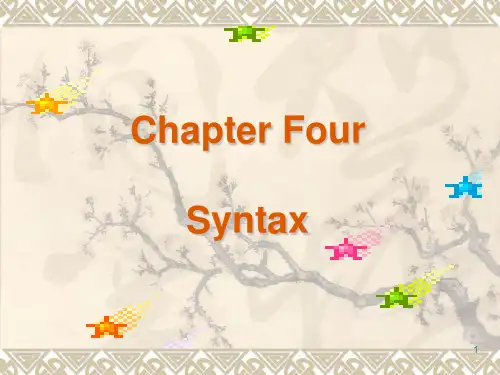


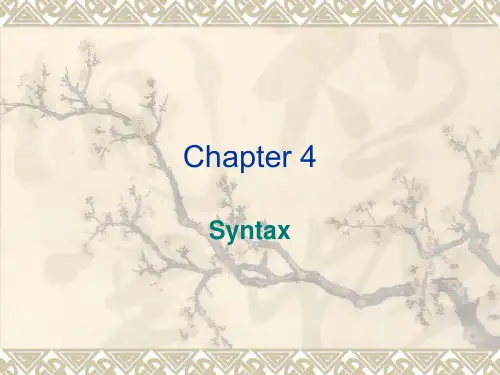

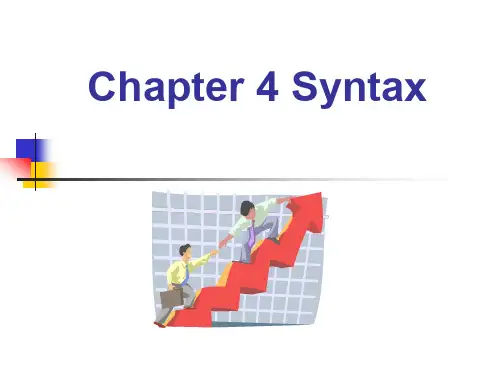
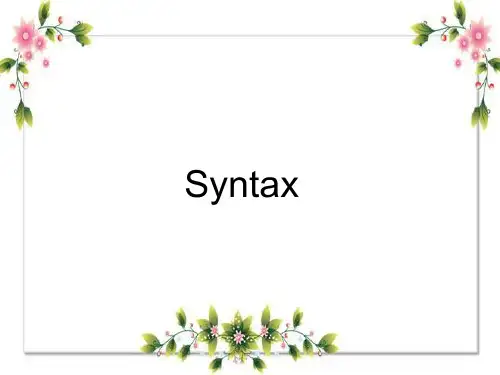

自考英语语言学Chapter 4 Syntax自考英语语言学chapter4syntax第4章语法I.本章大纲二、本章重点句法分析是语言学的一个分支,研究语言的内容和结构。
2022、说明;2022,选择1.syntaxasasystemrules句法规则系统当一个内容与说话者头脑中的语法知识一致时,它被认为是语法化的。
1)语言学中,句法学是和语音学,音系学,形态学,语义学等并列平行的次系统,主要是来分析研究语言的句子结构。
句法是一个由一套数量有限的抽象规则组成的系统,这些抽象规则称为句法规则。
根据句法规则,不同的单词组合在一起,产生符合语法性的句子。
句法学的中心是研究句子的结构成分。
2)句子的语法性意味着句子的合成必须符合母语人士头脑中的语法知识。
生成的句子必须符合语法。
3)单词合成句子,单词和句法规则的数量是有限的,但借助抽象的句法规则,可以将单词合成数量无限的句子。
一方面,说话者要想说出或理解符合语法性的句子,必须遵循句法规则;另一方面,说话者运用句法规则,可以表达或理解从未听说过的句子。
4)任何语言的句法规则必须能够描述和解释所有的母语者认为是规范的句子。
2.sentencestructure句子结构主语是指句子中所指的宾语,如人、物、物、地点、概念等。
谓语是指对句子中对主语进行表述或判断的部分。
通常由限定动词或动词词组构成。
谓语要受到人称、数、时态各语气的限制。
2.2句子类型句子的类型,句子可分为简单句、并列句和复合句三大类。
2.2.1简单句asimplesentenceconsistsofasingleclausewhichcontainsasubjectandapredicateandsta ndsaloneasitsownsentence.(2021填空)指一个句子中含有一个主语和一个谓语。
ACLauseThattached as object and finiteverb,而ametimes stands structurallyalone则被称为afiniteclause。
《语言学》Chapter4Syntax习题兼答案《新编简明英语语言学教程》第二版第4章练习题参考答案Chapter 4 Syntax1. What is syntax?Syntax is a branch of linguistics that studies how words are combined to form sentences and the rules that govern the formation of sentences.2. What is phrase structure rule?The grammatical mechanism that regulates the arrangement of elements (i.e. specifiers, heads, and complements) that make up a phrase is called a phrase structure rule.The phrase structural rule for NP, VP, AP, and PP can be written as follows:NP →(Det) N (PP) ...VP →(Qual) V (NP) ...AP →(Deg) A (PP) ...PP →(Deg) P (NP) ...We can formulate a single general phrasal structural rule in which X stands for the head N, V, A or P.3. What is category? How to determine a word's category?Category refers to a group of linguistic items which fulfill the same or similar functions in a particular language such as a sentence, a noun phrase or a verb.To determine a word's category, three criteria are usually employed, namely meaning, inflection and distribution.若详细回答,则要加上:Word categories often bear some relationship with itsmeaning. The meanings associated with nouns and verbs can be elaborated in various ways. The property or attribute of the entities denoted by nouns can be elaborated by adjectives. For example, when we say that pretty lady, we are attributing the property ‘pretty’ to the lady designated by the noun. Similarly, the properties and attributes of the actions, sensations and states designated by verbs can typically be denoted by adverbs. For example, in Jenny left quietly the adverb quietly indicates the manner of Jenny's leaving.The second criterion to determine a word's category is inflection. Words of different categories take different inflections. Such nouns as boy and desk take the plural affix -s. Verbs such as work and help take past tense affix -ed and progressive affix -ing. And adjectives like quiet and clever take comparative affix -er and superlative affix -est. Although inflection is very helpful in determining a word's category, it does not always suffice. Some words do not take inflections. For example, nouns like moisture, fog, do not usually take plural suffix -s and adjectives like frequent, intelligent do not take comparative and superlative affixes -er and -est.The last and more reliable criterion of determining a word's category is its distribution. That is what type of elements can co-occur with a certain word. For example, nouns can typically appear with a determiner like the girl and a card, verbs with an auxiliary such as should stay and will go, andadjectives with a degree word such as very cool and too bright.A word's distributional facts together with information about its meaning and inflectional capabilities help identify its syntactic category.4. What is coordinate structure and what properties does it have?The structure formed by joining two or more elements of the same type with the help of a conjunction is called coordinate structures.It has (或写Conjunction exhibits) four important properties:1) There is no limit on the number of coordinated categories that can appear prior to the conjunction.2) A category at any level (a head or an entire XP) can be coordinated.3) Coordinated categories must be of the same type.4) The category type of the coordinate phrase is identical to the category type of the elements beingconjoined.5. What elements does a phrase contain and what role does each element play?A phrase usually contains the following elements: head, specifier and complement. Sometimes it also contains another kind of element termed modifier.The role each element can play:Head:Head is the word around which a phrase is formed.Specifier:Specifier has both special semantic and syntactic roles. Semantically, it helps to make more precise the meaning of the head. Syntactically, it typically marks a phrase boundary.Complement:Complements are themselves phrases and provide information about entities and locations whose existence is implied by the meaning of the head.Modifier:Modifiers specify optionally expressible properties of the heads.6. What is deep structure and what is surface structure?There are two levels of syntactic structure. The first, formed by the XP rule in accordance with the head's subcategorization properties, is called deep structure(or D-structure). The second, corresponding to the final syntactic form of the sentence which results from appropriate transformations, is called surface structure (or S-structure).(以下几题只作初步的的成分划分,未画树形图, 仅供参考)7. Indicate the category of each word in the following sentences.a) The old lady got off the bus carefully.Det A N V P Det N Advb) The car suddenly crashed onto the river bank.Det N Adv V P Det Nc) The blinding snowstorm might delay the opening of the schools.Det A N Aux V Det N P Det Nd) This cloth feels quite soft.Det N V Deg A8. The following phrases include a head, a complement, anda specifier. Draw the appropriatetree structure for each.a) rich in mineralsXP(AP) →head (rich) A + complement (in minerals) PPb) often read detective storiesXP(VP) →specifier (often) Qual +head (read) V +complement (detective stories) NPc) the argument against the proposalsXP(NP) →specifier (the) Det +head (argument) N +complement (against the proposals) PP d) already above the windowXP(VP) →specifier (already) Deg +head (above) P +complement (the window) NPd) The apple might hit the man.S →NP (The apple) + Infl (might) +VP (hit the man)e) He often reads detective stories.S →NP (He) +VP (often reads detective stories)9. The following sentences contain modifiers of various types. For each sentence, first identify the modifier(s), then draw the tree structures.(斜体的为名词的修饰语,划底线的为动词的修饰语)a) A crippled passenger landed the airplane with extreme caution.b) A huge moon hung in the black sky.c) The man examined his car carefully yesterday.d) A wooden hut near the lake collapsed in the storm.10. The following sentences all contain conjoined categories. Draw a tree structure for each of the sentences.(划底线的为并列的范畴)a) Jim has washed the dirty shirts and pants.b) Helen put on her clothes and went out.c) Mary is fond of literature but tired of statistics.11. The following sentences all contain embedded clauses that function as complements of a verb, an adjective, a preposition or a noun. Draw a tree structure for each sentence.a) You know that I hate war.b) Gerry believes the fact that Anna flunked the English exam.c) Chris was happy that his father bought him a Rolls-Royce.d) The children argued over whether bats had wings.12. Each of the following sentences contains a relative clause. Draw the deep structure and the surface structure trees for each of these sentences.a) The essay that he wrote was excellent.b) Herbert bought a house that she lovedc) The girl whom he adores majors in linguistics.13. The derivations of the following sentences involve the inversion transformation. Give the deep structure and the surface structure of each of these sentences. (斜体的为深层结构,普通字体的为表层结构)a) Would you come tomorrow?you would come tomorrowb) What did Helen bring to the party?Helen brought what to the partyc) Who broke the window?who broke the window。
Chapter 4 SyntaxTeaching aims1. Overview of syntax as a system of rules that govern the formation of grammatical sentences.2. Overview the four phrases of syntactic study in the history3. Examine the composition of sentences in terms of category and structure4. Discuss grammatical relations between each noun phrase and the verb in a sentence.5. Introduce IC analysis and five phrases of generative approach.4.1 Introduction to syntaxSyntax consists of a set of abstract rules that allow words to be combined with other words to form grammatical sentences.Grammatical sentences & Syntactic rule1) Sentences are structured according to a particular arrangement of words. Well-arranged sentences are considered grammatical sentences.2) Grammatical sentences are formed following a set of syntactic rulesIntroduction to syntaxAccording to traditional approach grammar is divided into two parts: morphology and syntax.As a major component of grammar,Syntax is a subfield of linguistics that studies the sentence structure of language.Grammatical & ungrammatical sentencesA sentence is considered grammatical when it conforms to the grammatical knowledge in the mind of native speakers.On the other hand, a sentence violates a rule according to which words are organized, then native speakers will judge it to be an impossible sentence of their language.Syntax consists of a set of abstract rules that allow words to be combined with other words to form grammatical sentences.Grammatical sentences & Syntactic rule1) Sentences are structured according to a particular arrangement of words. Well-arranged sentences are considered grammatical sentences.2) Grammatical sentences are formed following a set of syntactic rules4.2 Syntax as s system of rulesDiscussion:Can we make a dictionary of sentences? Why or why not?Universally found in the grammars of all human languages, syntactic rules comprise the system of internalized linguistic knowledge of a language speaker known as linguistic competence.A theory of grammar must provide a complete characterization of linguistic utterances that speakers implicitly consider well-formed, or grammatical, sequences. .Universally found in the grammars of all human languages, syntactic rules comprise the system of internalized linguistic knowledge of a language speaker known as linguistic competence.A theory of grammar must provide a complete characterization of linguistic utterances that speakers implicitly consider well-formed, or grammatical, sequences. .The major goal of linguistics is, then, to show with a consistent and explicit grammatical theory how syntactic rules account for this grammatical knowledgeThe infinite numbers of sentences & Syntactic rule1) For any natural language, a set of syntactic rules are capable of yielding an endless number of sentences in that language.2) That is, the syntactic rules of any language are finite in number, and yet there is no limit to the number of sentences native speakers of that language are able to produce and comprehend.4.3.1 Lexical categories --- Word ClassA language has major and minor lexical categories of a finite set.1) Major lexical categories are open categories in the sense that new words are constantly added.2) Minor lexical categories are closed categories because the number of the lexical items in these categories is fixed and no new members are allowed for.English has four major lexical categories and six minor lexical categories, given below with examples:English Four Major Lexical Categories•Noun (N): student, linguistics, lecture, John•Verb (V): like, read, go•Adjective (Adj): tall, lovely, red•Adverb (Adv): loudly, constantly, hardEnglish has four major lexical categories and six minor lexical categories, given below with examples:•English Six Minor Lexical Categories•Determiner (Det): the, a, this, his•Auxiliary (Aux): can, will, do, be, have•Preposition (Prep): in, at, to, on•Pronoun (Pron): he, she, us, mine•Conjunction (Conj): and, or, but, while•Interjection (Int): oh, ah, eh4.3.2 Phrasal categories --- Phrasal ClassExcept for a very few number, lexical items have certain combinational properties that allow them to combine with words of different categories to form phrases.In English syntactic analysis, four phrasal categories are commonly recognized and discussed, namely, noun phrase (NP), verb phrase (VP) , prepositional phrase (PP), and adjective phrase (AP)The characteristics of phrasal categories1.NP and VP are essential components of a sentence, comprising the two major syntacticcategories, that is, the subject and the predicate of a sentence.2.Notice also that VP in a sentence may contain just a verb, with an optional noun phraseand/or a prepositional phrase;3.NP may contain just a noun, and AP just an adjective.4.NP: a tall man, the student5.VP: hit the student, walk with a stick6.PP: with a stick, in the park7.AP: quite rudeWords and phrases are organized according to the syntactic categories they belong to.•Apart from sentences (S) and clauses (C), a syntactic category usually refers to a word (called a lexical category) or a phrase (called a phrasal category) that performs a particular grammatical function, such as the subject in a sentence.•Constituents that can be substituted for one another without loss of grammaticality belong to the same syntactic category.For example:Which sentences are grammatical sentences?(1) a. The student liked the linguistics lecture.••b. The linguistics lecture liked the student.••c. *Liked the student the linguistics lecture.(2) a. John hit upon an idea.• b. An idea hit upon John.• c. *An hit John upon idea.4.4 Sentence structure (Traditional approach))Discussion:Since syntax deals with the sentence structure of language, we will then ask, among other things, such questions as what constitutes a sentence and what major types of sentences are contained in a language ?The basic components of a sentence1) A sentence is a structurally independent unit that usually comprises a number of words to form a complete statement, question or command.2) Normally a sentence consists of at least a subject and its predicate which contains a finite verb or a verb phrase.This referring expression is grammatically called subject.A subject may be a noun or a noun phrase in a sentence that usually precedes the predicate.The part of a sentence which comprises a finite verb or a verb phrase and which says something about the subject is grammatically called predicate.A finite verb, informally called the main verb of a sentence, expresses existence, action or occurrence which is limited by person, number, tense and mood.e.g. John likes linguistics.•In the above example, "John" is the subject, and "likes linguistics" is the predicate, which is a verb phrase consisting of a finite verb "likes" and its object "linguistics."•Here reference is made to John and something is said about, or predicated of, John.•That is, someone is referred to as "John," and this John "likes linguistics.•Traditionally, three major types of sentences are distinguished, namely, simple sentence, coordinate, or and complex sentence.A. The simple sentenceA simple sentence consists of a single clause which contains a subject and a predicate and stands alone as its own sentence.B. The coordinate sentenceA coordinate sentence contains two clauses joined by a linking word called coordinating conjunction, such as "and," "but," "or."•Traditionally, three major types of sentences are distinguished, namely, simple sentence, coordinate, or and complex sentence.• C. The complex sentenceA complex sentence contains two, or more, clauses, one of which is incorporated into the other. That is, the two clauses in a complex sentence hold unequal status, one subordinating the other.• A. Simple sentencese.g. John reads extensively.Mary decided to take a linguistics class the next semester• B. Coordinate sentencese.g. John is reading a linguistics book, and Mary is preparing for her history exam.John likes linguistics, but Mary is interested in history.• C. The complex sentencee.g. Mary told Jane [that John liked linguistics].Mary asked [John to buy her a linguistics book] .[ That John likes linguistics] puzzles everyone.B. Coordinate sentencese.g. John is reading a linguistics book, and Mary is preparing for her history exam.4.5 The linear and hierarchical structuresof sentenceLanguage is a highly structured system of communication. Sentences are not formed by randomly combining lexical items, but by following a set of syntactic rules that arrange linguistic elements in a particular order to make a string of words not only meaningful but also linearly and hierarchically-structured.(1) The linear word order of a sentenceWhen a sentence is uttered or written down, the words of the sentence are produced one after another in a sequence.•This sequential order of words in a sentence suggests that the structure of a sentence is linear as in the following examplese.g. (1) The student likes the new linguistics professor.(2) John, Mary and Susan went to the linguistics lecture.(2)The hierarchical structure of a sentence•The superficial arrangement of words in a linear sequence does not, however, entail that sentences are simply linearly-structured.•Intuitively, English speakers divide these sentences in the way that obviously follows aparticular hierarchical order, as is shown in (1-2) with different segmentation: •(1) The student // likes / the new linguistics professor.•(2) John, Mary and Susan // went to / the linguistics lecture.This type' of segmentation truthfully reveals the hierarchical nature of sentence structure: sentences are organized with words of the same syntactic category, such as, noun phrase (NP) or verb phrase (VP), grouped together.4.5 Tree diagrams of sentence structureIn a tree diagram, S is the root of the tree, occupying the topmost position, from where it branches into phrasal categories. E.g. NP, VP.In addition to revealing a linear order, a constituent structure tree has a hierarchical structure that groups words into structural constituents and shows the syntactic category of each structural constituent, and consequently is believed to most truthfully illustrate the constituent relationship among linguistic elements.4.5 Concord and government--- Grammatical relation (FY)Concord: It is known as agreement. It can be defined as the requirement that the forms of two or more words in a syntactic relationship should agree with each other in terms of some categories.e.g. this man, these menIn English there are several requirements for “number”, “gender”, and “tense”.Government: It is another type of control over the form of some words by other words in certain syntactic construction. It refers to the relationship in which a word of a certain class determines the form of others in terms of certain category.e.g. She give him a book.The former is governorShe give a book to him.The latter is the governed4.6 The Structural approach--- Proposed by Saussure and American structuralismIn the 20th century, some linguists collect samples of the language they are interested in and attempt to describe the regular structures of the language as it is used, not according to some view of how it should be used.•Structural analysis•Syntagmatic and paradigmatic relations•Immediate constituent analysis•Endocentric and exocentric constructionStructural analysis•Native speakers produce and comprehend sentences according to their internalizedknowledge of the rules, according to which words and phrases are organized.•S --->NP VP•We read the arrow as "consists of," or " is rewritten as," the sentence can be rewritten as, a noun phrase and a verb phrase. "NP structure : NP–(Det) (Adj) N (PP) (S)VP structure : VP–V+ NP+ PP+ (S)Syntagmatic and paradigmatic relationsIn Saussure’s view, language is a system of signs, which consists of two parts: Signified (concept) and Signifier (sound image).•In order to find value of the sign, Saussure identified two types of relations:1) Syntagmatic relation (组合关系) : It is a relation between one item and others in a sequence, or between elements which are all present.2)Paradigmatic relation (聚合关系)/ associative relationIt is a relation holding between elements replaceable with each other at a particular place in a structure, or between one element present and the others absent.Denotation and SenseWords also derive their value from their positions within the language system. The semantic links between elements within the vocabulary system is an aspect of their sense. The relationship between reference and sense is illustrated by Saussure.Each oval is a word, which has its own capacity for reference, but each is also linked to other words in the same language like a cell in a network.Syntagmatic and paradigmatic relationse.g.小王打碎了杯子小猫撞翻了花盆中国人民打败了日本帝国主义和聚合关系是互相有内在联系的两条规则。